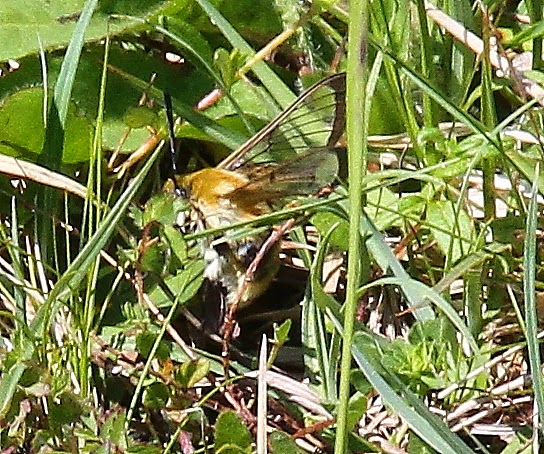With a few days of warm, sunny weather, it was the right time of year to go out Hawk Watching locally. I wasn't looking for a migrating Red Kite: we now have a small, but regular, Easterly movement of Red Kites through coastal Dorset on fine Spring days. I've assumed these are part of the reintroduced birds from the Home Counties, some of which I suspect migrate to the South West of the UK to Winter, before returning to their breeding sites in the Spring. Neither am I looking for a Honey Buzzard or Montagu's Harrier, which are even scarcer migrant Hawks which might be seen arriving in the UK at this time of year. No I'm thinking of a much smaller Hawk, Narrow-bordered Bee Hawk Moth. Like the Broad-bordered Bee Hawk Moth, they are on the wing in May to July in Dorset. They are most likely to be encountered at chalky sites in Dorset & their favourite foodplants are Devil's Bit Scabious, Small Scabious & Field Scabious. Broad-bordered Bee Hawk Moths foodplants are Honeysuckle & Bedstraw & they seem to prefer areas around the Dorset Heaths. One of the best places to look is Powerstock Common. I had been there the previous day, but I didn't have good directions to some of the best areas. With better directions, I decided to try again while the weather was good.
Narrow-bordered Bee Hawk Moth: A final photo showing the great face pattern
Pyrausta purpuralis: A fairly common downland day time flying moth
Marsh Fritillary: This was the only one I saw on the wing
Narrow-bordered Bee Hawk Moth: Think this is a female as I followed her around appearing to lay eggs
Narrow-bordered Bee Hawk Moth: I couldn't resist another photo as most views were of them belting across the Downland field like a high speed, straight flying Bee, before disappearing back up into the surrounding trees
Narrow-bordered Bee Hawk Moth: A final photo showing the great face pattern
Pyrausta purpuralis: A fairly common downland day time flying moth
Twayblade: This is a fairly common chalk downland Orchid in Dorset & Hants
Twayblade: Another shot of the flowers
Bugle: One of the more popular flowers for the local Butterflies & Moths
I took a different route back from Powerstock which gave me the opportunity for some more great views over this stunning part of the county.Bugle: One of the more popular flowers for the local Butterflies & Moths
Eggardon Hill Fort: This impressive Iron Age fort about 2,500 years old & is partly owned by the National Trust & partly privately owned
On the way home, it was such a warm, sunny afternoon, that I decided to have a look for an ultra elusive Great White Egret in Poole Harbour. This bird seems to roost in Poole Harbour & has been seen flying up & down the Frome Valley at varying times of day. There is no real pattern, other than it seems to roost in the Harbour & feed outside the area. After trying all my usual viewpoints over the Lower Frome Valley, I headed to a viewpoint inside Poole Harbour with a plan to stick it out to dusk to see if it flew in. 4.5 hours later as it was cooling down, I was beginning to regret not taking more clothing with me. But all that changed when I picked up the Great White Egret flying from the Upper Piddle Valley & heading towards the Arne Peninsula. My view as it got to Arne was blocked by trees so I couldn't see how far it went. Still I had managed to finally see it, after about 10 attempts over the past few months to find it feeding in the Lower Frome Valley. Perhaps part of the reason I was missing it, was as it was also feeding in the Lower Piddle Valley. But some mornings, it had been seen flying up the Frome. A long wished for Poole Harbour tick & probably only about the 10th reliable sighting by local Harbour birders, of a bird that's been around for several months.
Hairy Dragonfly: Female. I saw this fly around, catch a large insect eat it & then fall asleep. If only the GWE had been so straight-forward to watch it go to roost











